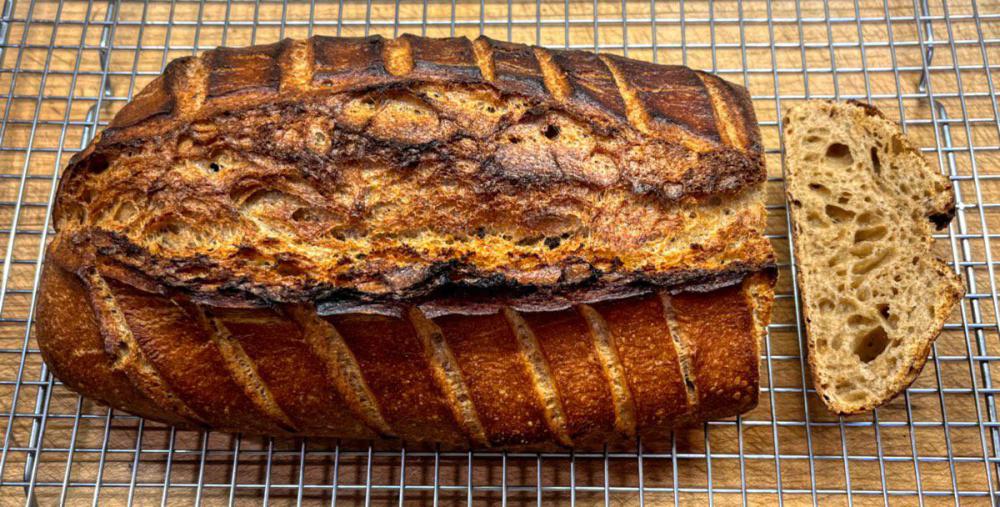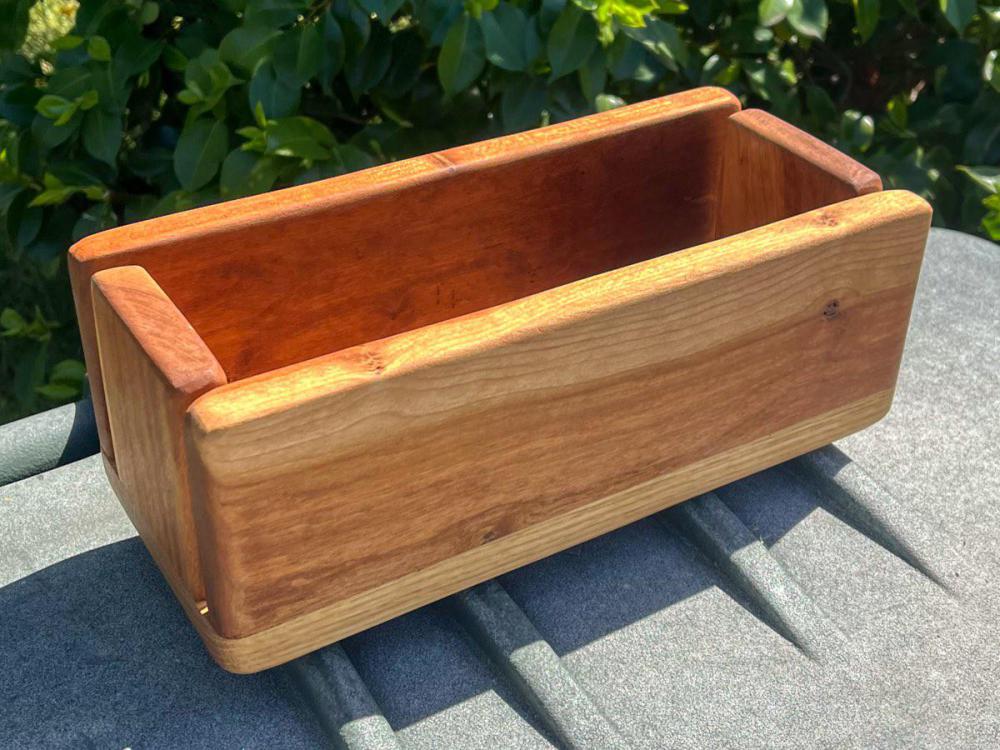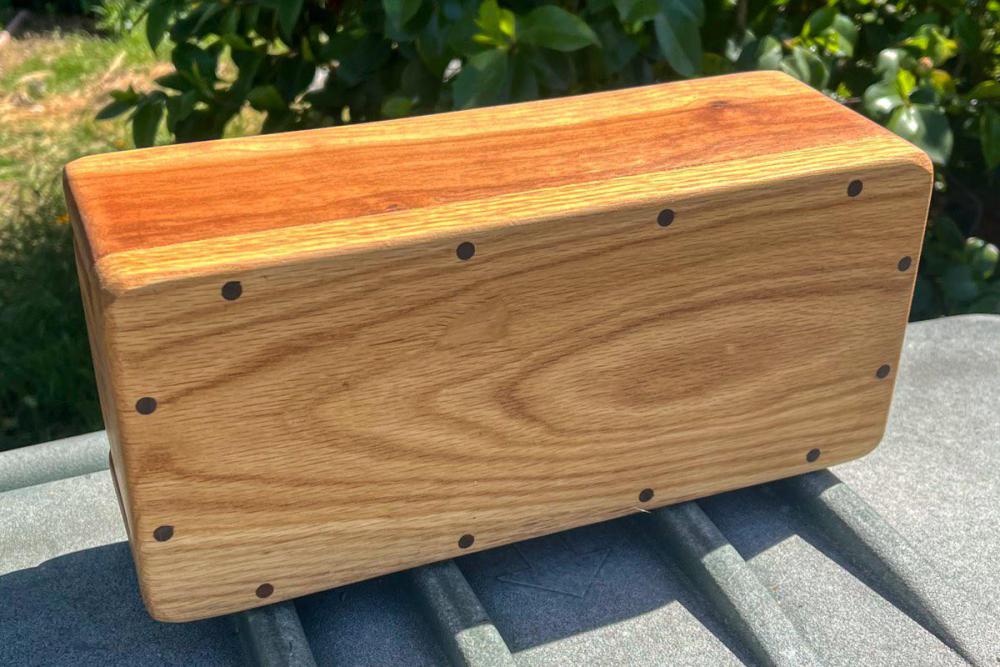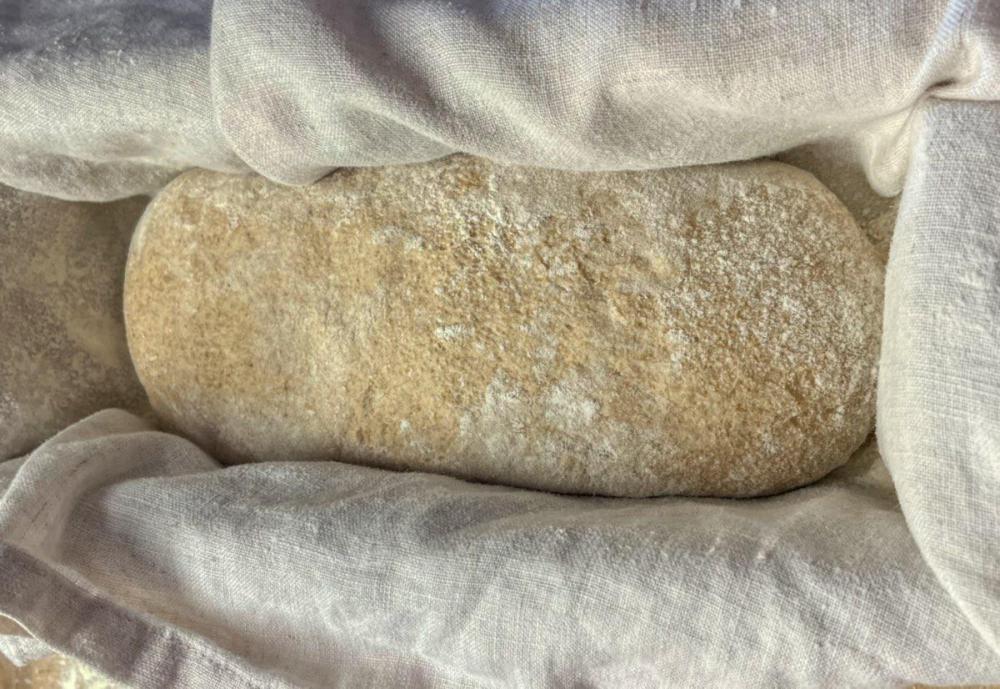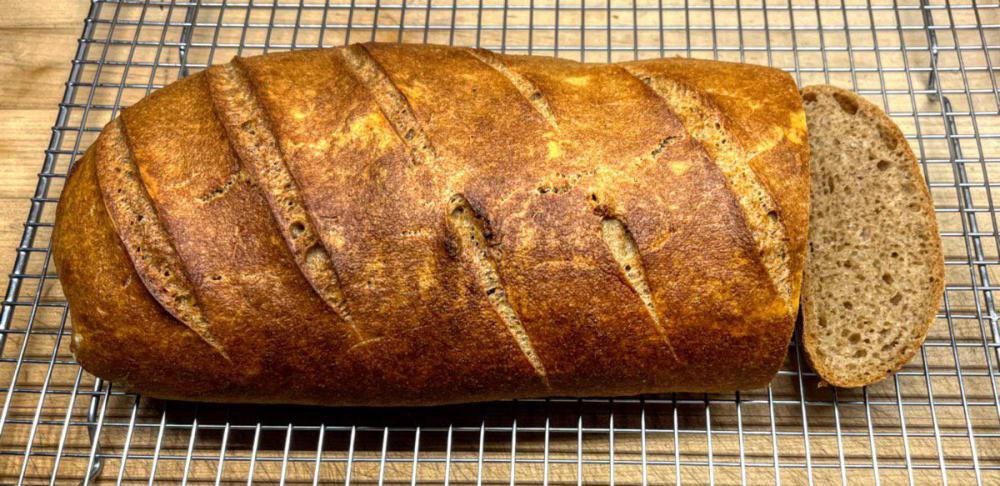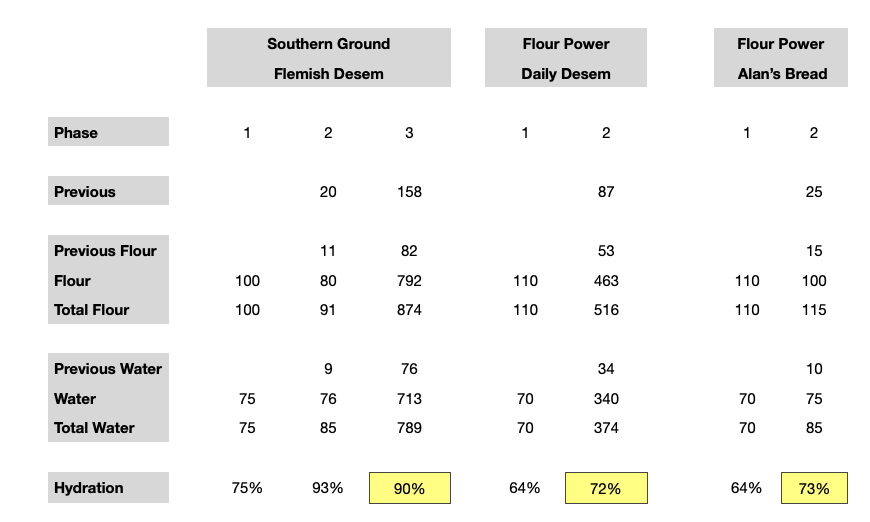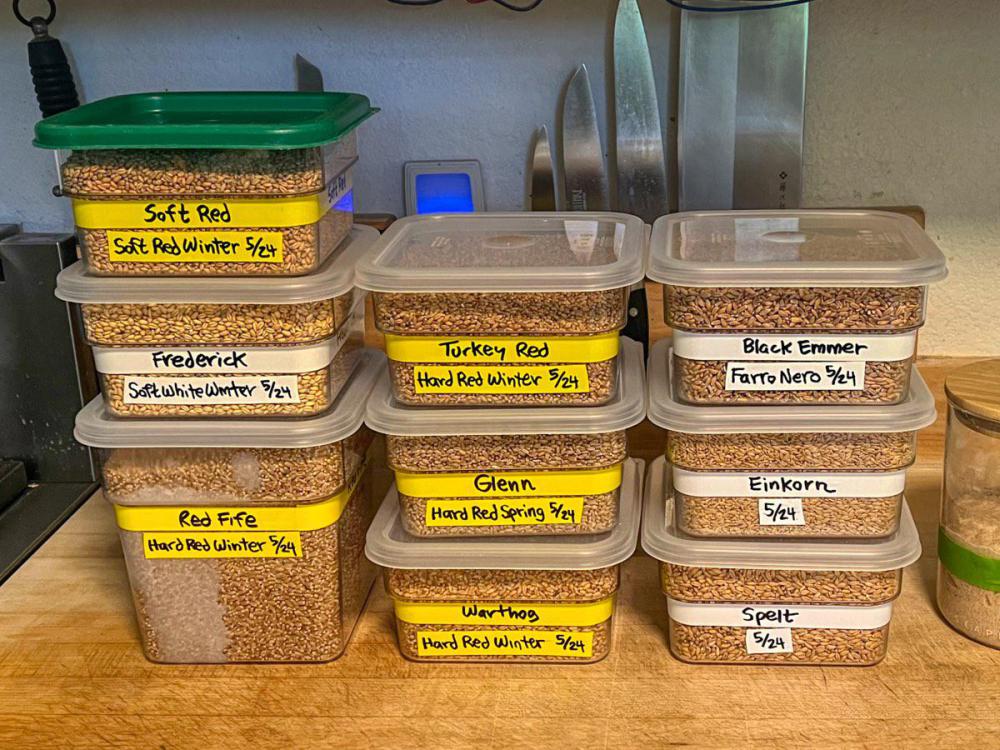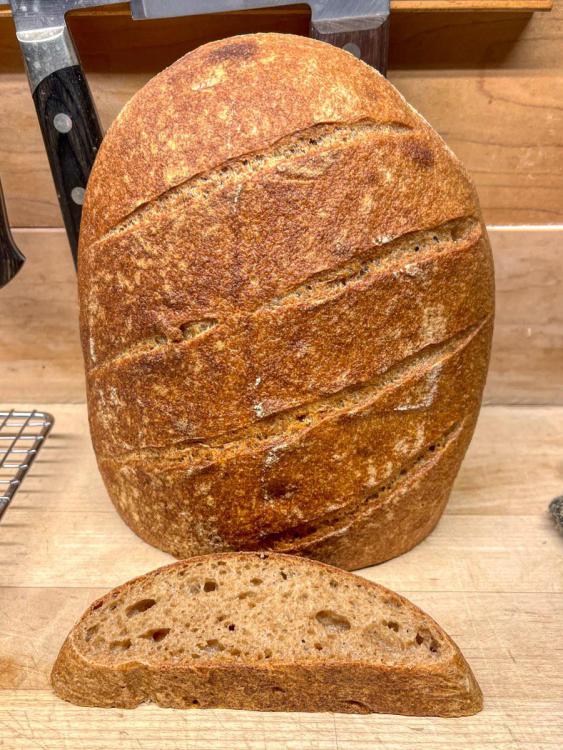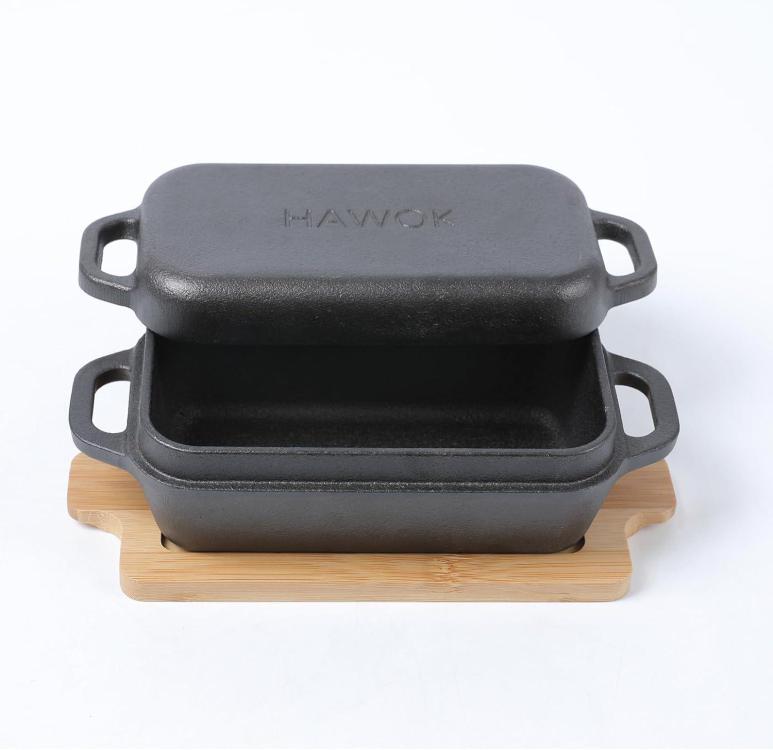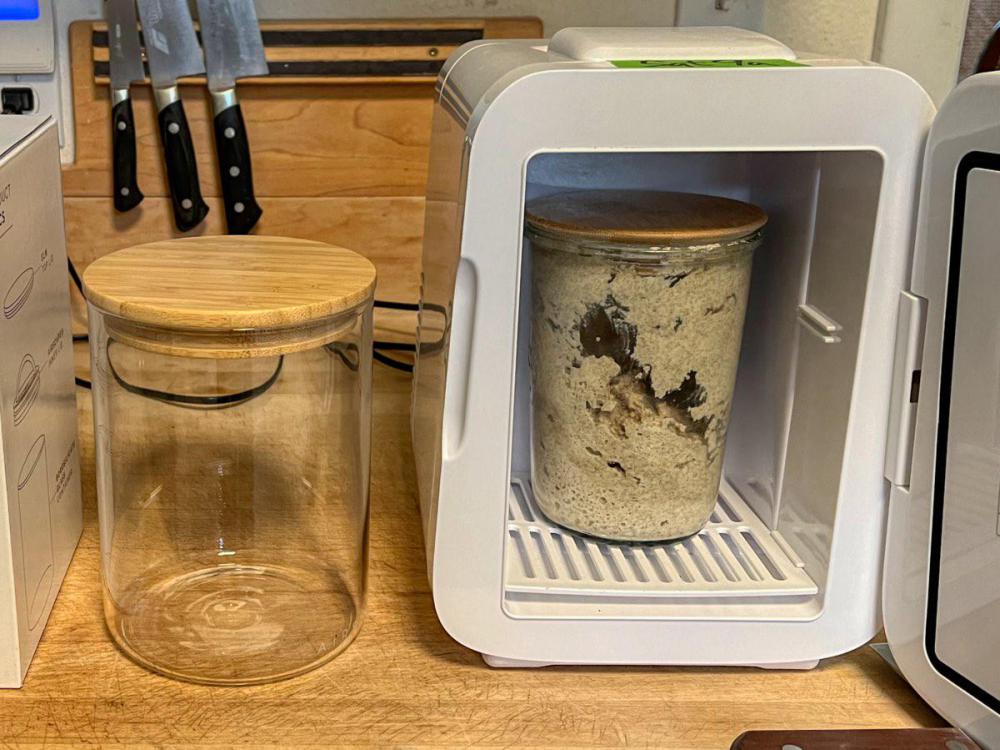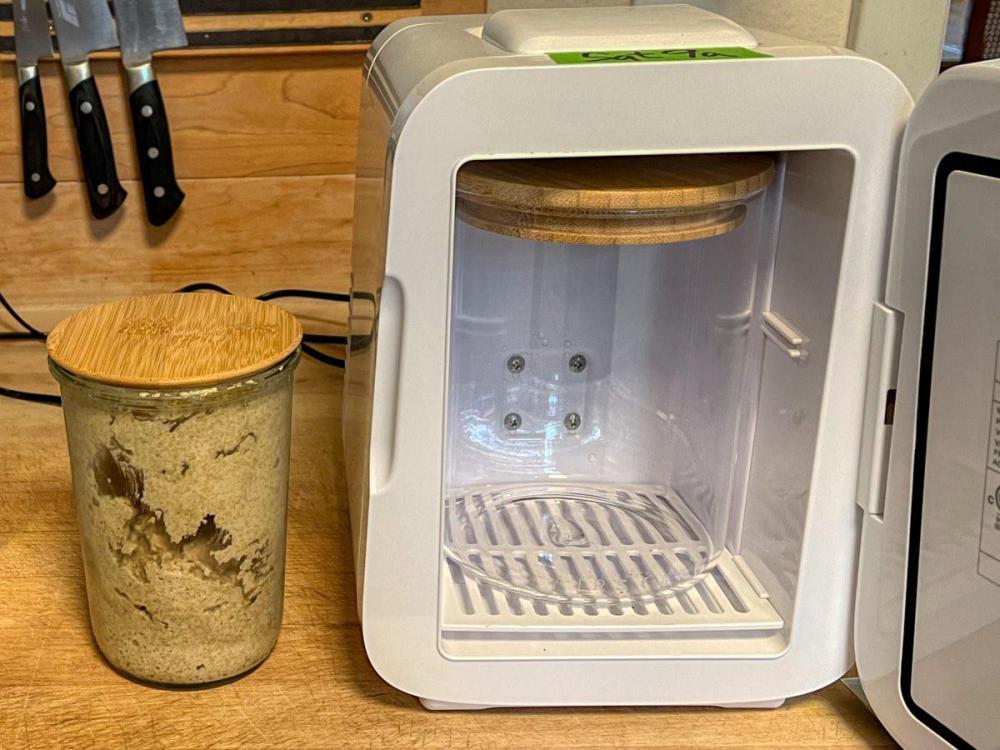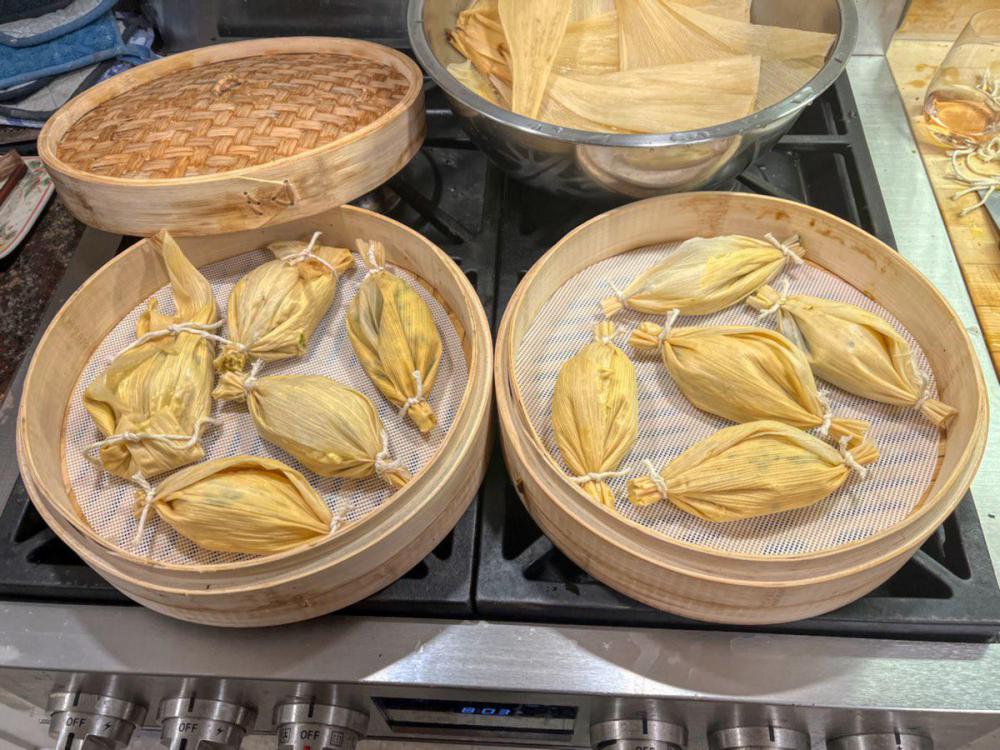-
Posts
1,747 -
Joined
-
Last visited
-
Days Won
53
Content Type
Profiles
Forums
Events
Everything posted by Syzygies
-
I have another book I overlooked: The Bread Builders: Hearth Loaves and Masonry Ovens by Alan Scott and Daniel Wing. Alan Scott was Laurel Robertson's friend and mentor to Jennifer Lapidus (Southern Ground). Desem bread is featured, and technical discussions rival those by Suas in Advanced Bread and Pastry (whose commercial orientation skips Desem). Of these, I want to work through every recipe I can from Southern Ground. Shown is North Carolina Sourdough, to try the '85' flour from her mill. Technically this was a pitch that turned into a passed ball, for so many reasons, but it tastes so good that we want to make it again right away, to see if we can figure it out. My new aspiration is to figure out Richard Bertinet's slap and fold technique for kneading bread. I need more gluten structure with less effort. It's harder than it looks, which is evident in the videos where someone else picks up the same dough, and can't skit across it like a waterbug.
-
I just searched for Desem in recipes indexed by Eat Your Books. The three books that come up are Flower Power, The Laurel's Kitchen Bread Book, and Southern Ground. This of course misses out-of-print books like The Bread Book by Thom Leonard, but at least we haven't missed anything obvious.
-
For today's Desem bread I made a proofing cradle from wood. I'm at the limit where my dough will sploof out into flat bread. A classic proofing basket is already wider than the wood frames I've been using for years. My frames had no bottom, but now I want to finish proofing in the fridge. For flavor, and as a bonus so the loaf better holds its shape. So now I needed a bottom. There are gaps by the four corners (which is fine for a proofing basket) so that wood expansion doesn't crack the box. Wood responds to changes in humidity by expanding across the grain. The poster child here is a beginner woodworker who makes cutting boards for gifts, and mixes end and side grains. Their boards crack. If one studies drawer construction, the bottoms float to avoid this issue. I prefer a chunkier solid proofing cradle, for thermal mass. You'd think my design would be everywhere, but I've never seen it before. In the same spirit as my artistic tirade above, this box uses my favorite cheater joinery. One shouldn't glue end grain without further support. People who understand wood believe that a hand cut dovetail joint displays the pinnacle of craftsmanship, even though box joints are stronger. People who make box joints tend to use jigs, then they look like every commercial box you've ever seen. What I do is plan and dry assemble my joinery using cabinet screws, then glue using the screws for clamping. Once the glue dries, I remove (and reuse) the cabinet screws, and replace them with Miller dowels. I then sand further and finish with Tried & True Original Wood Finish polymerized linseed oil and beeswax, which is food safe. My box is shown sunning in our yard, so the bread won't taste like linseed oil. This is dead simple joinery that I'd recommend to any casual woodworker. My friends who don't judge art by difficulty, or who are simply oblivious to measuring difficulty for wood joinery, love this style of construction.
-
I added her Daily Desem, which is about the same hydration. Yes, she calls for "full" extraction white and/or red whole wheat flours in the two recipes. Perhaps some people actually use 100% extraction flour? I put mine through a coarse sieve, ending up with 95% extraction, which can (nearly) handle 90% hydration. I'm going to drop a few percent at a time to see what happens.
-
My impression is that as a rule, Desem bread uses high hydrations. I was startled, reading Flour Power, how little water she uses. My earlier sources use clumsy Imperial volume measurements, making comparisons less precise, but I believe that Southern Ground is closer to usual practice?
-
Alas I noticed. We'll meet there, if not sooner. Oddly, Tara Jensen's web site makes no mention that I can discern as to the location of her upcoming workshop?
-
Ha! My wife Laurie is my muse, saw where I was going with the Brød & Taylor Sourdough Home, and recalled reading the Desem section in The Laurel's Kitchen Bread Book, back in the 1980's when it came out. I sensed a seminal work, akin to Richard Olney's Simple French Food spawning the Chez Panisse diaspora. Sure enough, Jennifer Lapidus read that same passage back in the day, and tracked down Laurel Robertson's dear friend Alan Scott, who became her mentor. She bought his 5,000 pound, 48-inch stone mill when he died before receiving it, and used it to found Carolina Ground. Her book Southern Ground is my new bible; as @Pequod discovered it's basically about Desem bread. I'm working through the Kindle edition until her signed copy arrives. Tracing back her sources, I found a used copy of The Bread Book by Thom Leonard. It's yet another take on Desem bread, worth reading. I've learned a few things I hadn't put together, such as slack bread could be overly digested by the sourdough starter. Meanwhile, my grain order from Janie's Mill arrived, to supplement our stocks of hard red spring wheat from Central Milling, and soft wheat and rye from Giusto's. Let the games begin!
-
In defense of "no pics", my last two loaves of sourdough have radicalized me. They looked like I'd been set back five years, and they tasted the best I've ever made. Now I'm on a Desem bread bender. For a period I joined a pottery studio nearby. One open house evening, I bought five "lottery" tickets when it looked like no one would, just to support the place. Eventually, many tickets sold. Yet, somehow, all five of my tickets won. I got kidded about this for months. One of my prizes was a bowl the owner had made but couldn't sell. My neighbor is now very happy to have it. The bowl extended for an inconceivable distance. It displayed a mastery of technique, the impossibility of which would only be clear to someone who had spent years trying to master the potter's wheel. I have a strong aesthetic bias, that in fact it's easier to display exceptional technique than true originality. This is certainly true in math. Every artistic endeavor gets distorted by this, to the point where we teach ourselves to judge the difficulty of something, rather than its artistic merits. My favorite piece that I made at that pottery studio was a pen holder. In India, before styrofoam cups, disposable cups were made of clay, and after use they contributed to the road. I tried to imagine what a pen holder would look like, made a few seconds each in the millions, if that India instead needed pen holders. Needless to say, this work was divisive. At least no one could accuse me of flaunting my skills with clay. This applies to food, which can be tricky to assess by appearance alone.
-
What's a YouTube live track that would convince this old Deadhead that Phish is more than a Pepsi/Coke thing for people too young for the Dead?
-
I have a levain (leaven) question for our fellow sourdough bakers: I'm trying some new recipes that begin by using some sourdough starter to make a levain, then later incorporating that levain into dough. I like to streamline processes when simplifying steps hardly matters. I've always made sure that my starter wakes up properly in its final few feedings before making bread, and that I have enough starter to make bread, then my own recipes just use some starter to replace the levain step. I've long understood that starter hydration affects the kind of acidity that forms. My new sources also see hydration as an adaptation to temperature, choosing a 75% to 80% hydration for starter kept at 50 F (10 C), but closer to 100% hydration for a levain kept at room temperature. On the other hand, various authors see starter as adaptable. Just as starter can adapt to a variation of feed cycles and temperatures, it can adapt to a variation of hydrations. Some people will even vary the feed, from mostly rye to mostly wheat, depending on what bread is up next. My new interests involve taking longer to develop deeper flavors. It's not even clear to me that I want to change the hydration and temperature of my starter in preparation for baking, if a colder starter simply needs longer to work. "You say that like it's a bad thing!" My favorite sources are adapting from commercial artisanal bakeries. When baking at scale, I can imagine that the levain step represents a significant scaling up from the starter, so it's natural to make this distinction. The authors perhaps didn't even consider whether a one loaf baker would be just as happy adapting the starter. At the other extreme, I've long admired the idea of simply remembering to save some dough for the next loaf. So for home baking, one loaf at a time, does anyone see an advantage to a separate levain step, rather than simply tweaking one's starter to match the next loaf's levain recipe, then reverting to usual starter on the next feed?
-
Mini Cast Iron Bread Maker, Loaf Pan Lid: 7.9''L x 3.7''W x 0.8''H Pan: 7.9''L x 3.7''W x 2.1''H I propose this as an example of a category, not a specific product recommendation. I am intrigued by the lip, one might get away without flour paste, perhaps inverted. It's small, could be used where round 1 or 2 quart pots wouldn't fit.
-

Brød & Taylor Sourdough Home
Syzygies replied to Syzygies's topic in Bread, Pizza, Pastries or Desserts
Here are screen grabs from their instruction manual, and a link to their blog post with more information: How to Use the Sourdough Home | Brod & Taylor -
In KK Bread Making Tips and Tricks, @Pequod posted about his new Brød & Taylor Sourdough Home, a temperature controlled chamber for ideally maintaining a sourdough culture. That is a long and interesting thread, that devolves into speculation about my cannabis use and so forth. The Komodo Kamado forum has great advice from some very serious cooks, and sometimes that advice draws in visitors who decide to stay and buy a Komodo Kamado, and become valued compatriots. So I thought it would be worthwhile to start a new thread focused on the Sourdough Home. I bought one immediately. The short-term payoff is being able to feed one's starter less frequently without inducing a refrigerator coma, then get it nice and warm for making bread. My first bread this way was a technical flop but the best tasting bread I've made in years. This makes it clear that the long-term payoff is learning to bake with better controls. Sure, people have made wine for centuries before electronics, but they had access to stable temperature caves, and they adapted their methods to reliable conditions. Modern wine is arguably better, in part because one can control conditions precisely. I'm convinced that one can learn to make astounding bread by learning how to use the Sourdough Home to control conditions. The Sourdough Home is not silent, and even in sleep mode a brighter light source than all of my other LEDs combined. If you live in a studio apartment, you'll likely end up pitching it out the window. An internet search reveals that a 3/4 liter "743 Weck Mold Jar" with a wooden lid is an ideal starter container (Amazon). Remove the silicone lid seal, so gases can escape. I like mine. After briefly searching for a bread proofing chamber, I realized that dough for my single loaves should fit in the Sourdough Home itself, if I could find the right container. I got lucky, and found the Airscape Glass Coffee Canister (Medium 7-Inch) with a two quart capacity. It exactly fits the Sourdough Home, with a similar wooden lid and a silicone seal one removes. It looks like a matched pair with the Weck starter jar, as shown in the photos. I've never had much luck with refrigerator dough rises, but the Sourdough Home allows for intermediate bulk proofing temperatures. My goal now is to adapt the idea of Desem bread (as detailed for example in The Laurel's Kitchen Bread Book; we already grind our own flour) to the possibilities of this equipment.
-
I've made countless experiments over the years, including attempts to adopt ideas that have worked for others. I keep coming back to cast iron. One can find arbitrarily small cast iron pots with effort. The most common mode of failure I've experienced is a breach, where either the lid displaces or a space opens between the lid and pot. Now convection burns the wood in the way we're trying to avoid. Thin steel deforms easily. An unsecured cast iron lid usually stays on, but smoke pots can tip as the fire shifts. I don't care how small the chances are here, I would find it unacceptable to lose a cook, particularly if it's for an event where others are depending on my BBQ. The flour paste seal for a cast iron lid is easy once one establishes a routine, and reminds me of the romance of using questionable pots in Moroccan cooking. I've never actually seen my three 1/8" holes clog, even though my wood could be in contact with the holes. A single hole would probably work, but one never wants to build a bomb, and three holes is not a liability. Do the holes need to face down? This was based on watching how one makes charcoal, where the exhaust becomes a self-sustaining flame at temperatures well above low & slow. Dunno how important "down" is, but down is better than up, and I have to point the holes some way. (I came up with the smoke pot idea after some ill-advised experiments at making charcoal...) If I had investors for a state-of-the-art BBQ restaurant in Manhattan, I'd design a method of heating wood in external chambers, and feeding the gas produced to a modified standard gas oven. I'm surprised that no one has tried this. Usually when people are unhappy with smoke pots, they're having trouble getting them going. I like starting my fires with a weed burner propane torch. For low & slow one wants a fire in one spot, so the fire doesn't run away. If one lights that spot under a smoke pot, one can arrange to get the smoke pot going too. This is fire tending, not fundamentally different from any other form of fire tending. One learns with practice. I don't give up. Alternatives? A mandatory PSA is required here, not all metals belong in a smoker. Galvanized metals in particular off-gas toxins one doesn't want near food. Never break with tradition without understanding what one is doing. Long ago, others followed my smoke pot experiments by building "pipe bombs", stainless steel threaded pipes with caps, with multiple holes along the bottom edge. These were expensive, but avoided the flour paste lid sealing ritual. For a bento box one would want a smaller pipe, bringing down the expense. Could one use other metals? See above. Texas oil rigger BBQ recycled job-site drums. I'd just go with stainless steel, to be sure. With several holes and ordinary wood as filler, I can't imagine sufficient pressure building to create a bomb. On the other hand, in math we observe that lack of imagination isn't a proof of anything. A reasonable design principle is that you can never design something not to break, but you can and should design how it breaks. Would pipe caps really need to screw on, or could one rig something that slid together, perhaps with enough overlap that there was no need for flour paste? Try multiple ideas, with care!
-
I've used grape vine cuttings, and fig (a bit odd) but not olive wood. Here's what ChatGTP-4 said:
-
Their chat recommended masking tape. I asked how to vent a box; they said leave the back open. [ I started a new thread, Brød & Taylor Sourdough Home ]
-
The Sourdough Home is a clean design that works. My one objection so far is light pollution. Up till now, the brightest object in our night environment has been our SimpliSafe home security Base Station. We keep it far from our sleeping quarters, and it's too bright even with the light ring wrapped in electrical tape. The Sourdough Home ("Starter home?" "Starter marriage?") has a sleep mode, but even that generates more light than the other 50 LED sources in our night home. I can imagine someone in a studio apartment frickin' despising this thing. [ I started a new thread, Brød & Taylor Sourdough Home ]
-
I'm a heretic here. There's a history saying, conquer China and you will become Chinese. Here, local conditions win. When I lose a starter, I just add a teaspoon of yeast to the first feeding, and pretend I have starter. If you've baked with yeast in your kitchen in the past decade, yeast will get in. Otherwise, the starter is largely determined by what's on the flour you use to feed it. It doesn't matter if you get starter from St. John Restaurant, or a winery gives me starter dating to the California Gold Rush; the starter will be the same in a few weeks, adapting to local conditions. In the meantime, you're baking with old dough, also a respected tradition. [ I started a new thread, Brød & Taylor Sourdough Home ]
-
Yes, as I just discovered. Their 20% off first purchase doesn't apply. I did order one. I'm a bit surprised that they don't help you manage a feeding schedule, now that it's no longer each day. My Joule sous vide unit, for example, uses a phone app because that was actually the least expensive option for them. [ I started a new thread, Brød & Taylor Sourdough Home ]
-
Brod and Taylor Sourdough Home Um, wow. This looks radically useful. We see pretty extreme temperature changes in our kitchen, season to season. I can believe that this matters but how much? One of my first lessons in cooking was asking a maven friend in college (now a country doctor) about cheesecake. He told me the four people on our 1,200 student campus who were most proud of their recipes. I interviewed each of them, threw out the superstitions (walk in socks by an ajar oven for an hour afterwards), and intersected their recipes to obtain what anyone now would recognize as one version of a classic cheesecake. This taught me about efficacy. In the kind of optimization that makes companies rich, they get numbers next to each lever revealing how important that lever is. In cooking, most levers are fantasies that hardly matter, even as the best cooks pile up a series of 1% advantages into striking results. So cooking well involves making some deep judgements about what matters, all while relaxing with a beverage of choice. The idea of slowing down my feeding schedule between bakes is very appealing. I hadn't considered seed ratio; I get fine results with less seed, but as always that impression says more about my mental health than whether I'm right. People always say this when they're happy with what they're doing, usually because they're unaware they could do better. The 100% hydration ratio they use in their examples leans hard to one extreme, favoring a certain acid profile. I use this too because it's easy and I'm lazy, but I recognize there's a choice here. Perhaps they address this deeper in their instructions, but I'd believe this choice to be more significant than the variables they do control. Which brings me back to "How much does this all matter?" [ I started a new thread, Brød & Taylor Sourdough Home ]
-

Nixtamal / masa / tacos from Masienda Oaxacan corn
Syzygies replied to Syzygies's topic in Techniques
Yes! We're getting closer to fresh corn season (having past fresh fava bean season) and we love the idea, but we've overdone dressed kernels off the cob. (Olive oil, salt, pepper. A great add-in for pasta or tacos, but one can only eat so much straight.) I thought of fresh corn as a masa add-in for tortillas, but that's a poor idea. Tweaking tamale dough with fresh corn sounds great, I'll experiment too. Along the same lines I love the idea and taste of plantains, particularly ripe plantains, but I can't bring myself to keep preparing and eating fried slices, as is the common side to rice and beans in Caribbean cooking. In her Oaxacan cookbook, Diane Kennedy notes that plantain was a masa filler when corn ran short. That sounds great as a tamale tweak, too. -

Nixtamal / masa / tacos from Masienda Oaxacan corn
Syzygies replied to Syzygies's topic in Techniques
(Someone should send @PVPAUL a McLaren 750S Spider, to see what he cooks for them!) -

Nixtamal / masa / tacos from Masienda Oaxacan corn
Syzygies replied to Syzygies's topic in Techniques
(I freely recognize how absurd my tamales look. Hopefully I freed others to not worry about appearances. It was the height of arrogance to just "I know how to cook!" wing it, rather than watching a few tamale making videos. Tamales really are much less work than this!) -

Nixtamal / masa / tacos from Masienda Oaxacan corn
Syzygies replied to Syzygies's topic in Techniques
We made way too much masa for a party last Sunday, starting with 600g corn which is pretty much the limit for wet grinding in my Premier Chocolate Refiner (fancy Indian wet grinder). I ended up with a pound of leftover masa, even after making too many tortillas. When I gave my New York masa grinder to @PVPAUL he sent us a dry ice freezer care package, including mole, and tamales, which inspired us. Last night I used some leftover KK pulled pork in a riff on a Serious Eats tamale recipe (I grilled the peppers outside on my Solo Stove fire pit). These were the best tamales I've eaten in my life. Tamales are a world changer: One can improvise fillings even more broadly than for tacos, the masa can be frozen more effectively if it will be turned into tamale dough, ... I've always thought mole sauce was one Holy Grail I wanted to master, and yet I didn't understand how to use mole sauce. Tamales might be second night leftovers for a Mexican, but I'm happy to prepare mole sauce to use in batches for tamales. LIGHT BULB TIME: Grinding nixtamal into masa in a wet grinder can take some tending, because an Indian wet grinder is tuned for wetter mixtures such as dosa batter. But one makes tamale dough from masa by adding lard or oil, water or stock... ?? If I make my tamale dough straight from nixtamal in a wet grinder, including all wet ingredients, can I just run the grinder unattended, as if I were making dosa batter ?? -
I never made a spelt recipe? Here is my most recently revised Numbers spreadsheet. Sourdough Bread.numbers


